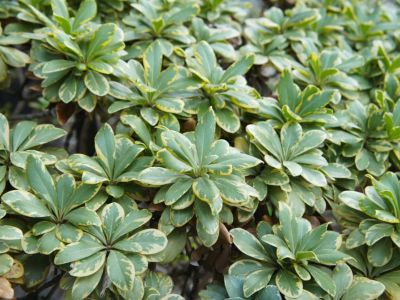Pittosporum Information
Pittosporum plants are moderate to slow-growing bushes with whorled leaves of either glossy green or variegated white. The plants produce fragrant, creamy-white flowers at the ends of the stems, set in clusters. At maturity, the plants may get 12 feet (4 m.) high with an 18 foot (6 m.) spread. The thick foliage makes the plant an excellent screen en masse, but it can also be an interesting single or multi-stemmed stand-alone tree. For coastal dwellers, an important piece of Pittosporum information is the plant’s excellent salt tolerance.
How to Grow Pittosporum
This is a very versatile plant and thrives equally well in either shade or sun. Propagation, or how to grow Pittosporum, is through semi-hardwood cuttings in summer. Place the cutting in a half and half mixture of peat and perlite. Keep the pot lightly moist and soon you will have another Pittosporum baby to enjoy. The plant does produce small fruits with bright red seeds, but the seeds are not easily sprouted and are often not viable.
Japanese Pittosporum Care
The tolerance of this plant is nearly legendary. In addition to its ambivalence regarding lighting, it can also grow on almost any soil. It is drought-resistant, but the plant is most beautiful when it does receive regular irrigation. Use mulch around the root zone in hot areas, and plant in an eastern exposure at the highest hardiness zones to prevent sunscald. The most important aspect of good Japanese Pittosporum care is to ensure the planting site has adequate drainage. While the plant grows best when it has regular water, it doesn’t tolerate wet feet and is also susceptible to a host of fungal diseases. Water at the root zone to prevent foliar disease and fertilize in spring with an all-purpose, slow-release plant food.
Trimming Pittosporums
Pittosporum plants are very tolerant of pruning. Trimming Pittosporums helps shape them and keep them within a desirable size. They may be headed back for sizing or even severely cut back for rejuvenation. As a hedge, you won’t get a smooth appearance because you need to cut under the whorled leaves and they are staggered. However, pruning below the terminal leaf arrangement produces a natural, soft-looking hedge. Annual pruning as part of the care of Pittosporum may reduce the scented flowers. To encourage blooms, prune right after flowering. Remove the lower branches if you wish to have a small tree appearance. You can keep the plant in a small size for many years by consistently trimming Pittosporums. However, a better approach if you want a smaller plant is to purchase ‘MoJo’ a small plant that gets only 22 inches (56 cm.) high, or a dwarf variety like ‘Wheeler’s Dwarf’.
